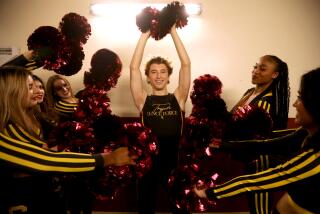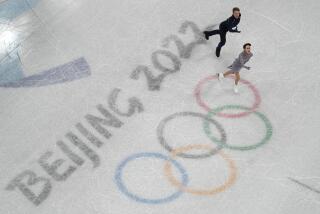Torvill and Dean : Skating Pair Didn’t Put Themselves Into the Record Book by Going by Rule Book
- Share via
Great Britain’s Jayne Torvill and Christopher Dean, better known in London’s Fleet Street tabloids as T&D;, were as close to perfect as any ice dancers have ever been. On one night in 1983, they were perfect, becoming the only skating team ever to be awarded maximum scores of 6.0 by all nine judges.
You could look it up in the Guinness Book of World Records, although considering the variations in scores that often are produced by the political nature of judging, their accomplishment belongs in Ripley’s Believe It Or Not.
In 1984, Torvill and Dean won gold medals at the Winter Olympics in Sarajevo, Yugoslavia, finished first in the world championships for the fourth straight year and then retired from competitive skating, having proved everything there is to prove in the sport.
What have they done since those days when they were the world’s best?
Gotten better, they said during a recent visit here in preparation for their Ice Capades debut, Oct. 22-Nov. 1, at the Forum
“The mentality of skaters is that the Olympics are like a curve,” Dean said. “You’re on a downward trip thereafter.
“But we don’t necessarily see everything as a downward trend. We had a narrow field of what we could and couldn’t do. Now, we have a much wider vision because we’ve worked with a lot more people in different areas of theatre and dance.
“So we feel we’ve gained a lot more experience, and we’ve performed so much more. When we were amateur skaters, we would perform maybe four or five times a year. Hopefully, we’re still on an upward spiral.”
Assuming that is the case, the suggestion was made to Torvill and Dean that they would be conceded two more gold medals if it were possible under International Skating Union (ISU) rules for them to compete in the 1988 Winter Olympics next February in Calgary, Canada.
Not so, they said.
Their reluctance to accept the premise is not born of modesty, although both appear to have disarming allotments of that. Nor is it because the level of skating in ice dancing has risen dramatically since 1984. In fact, the opposite has been true. There are no ice dancers today who could carry T&D;’s ampersand.
But even if the 1984 champions were eligible for the Winter Olympics, one of the current teams might win in Calgary because of rule changes that were instituted by the ISU in 1985. Many people in ice skating believe it is not coincidental that the changes came immediately upon the retirement from competitive skating of Torvill and Dean.
They may or may not have been ahead of their time. But they certainly were ahead of the ISU’s time, which generally is considered to be about 1952.
The routine that Torvill and Dean performed to Ravel’s Bolero in Sarajevo was innovative, passionate and, worst of all in the eyes of ISU officials, modern. They would have preferred a nice waltz.
“I think they see ice dancing as an extension of ballroom dancing,” Dean said. “We see it is an extension more of contemporary dance. That’s what skating is. It’s new. It’s contemporary.
“They’re not stimulating people’s ideas. You can’t do this. You can’t do that. They don’t really have an open mind, a broad view of ‘You can do anything, and we’ll judge it for what it is.’
“They certainly changed a few things that we did. They introduced a lot of regulations. Even Bolero , we couldn’t use that in competition now.”
Torvill apparently had not considered that before.
“You mean the music or the whole thing,” she asked Dean.
“It would be illegal,” he said.
“The whole thing?”
“Yeah,” he said.
She thought for a moment before, in a stereotypically British understatement, said, “So it’s gone backwards, I think.”
That was apparent at the world championships last February in Cincinnati, where ice dancing, which received even more attention than the men’s and women’s individual competitions in Sarajevo, was treated like a poor relation to the other events.
“We went to the world championships for the first time since we finished competing,” Torvill said. “The dance event, of course, we were interested in, but it wasn’t the most exciting. The top groups were exciting, but lower down, because of restrictions and so on, it wasn’t so interesting.
“The new rules have stopped a lot of them, the ones who are capable of being creative, because they are so scared of being marked down for doing something different.”
No one would ever suggest that Torvill and Dean ever were inhibited by the rules. In their choices of music and choreography, they occasionally went beyond even the more liberal guidelines that were in effect when they competed.
“Jayne and Christopher went well beyond the rules,” said Judi Blumberg, an ice dancer from Tarzana who, along with partner Michael Siebert, finished fourth in the 1984 Winter Olympics. She and Siebert lost bronze medals because the judges determined they had not paid close enough attention to the rule book.
“I don’t mean that in a bad way,” Blumberg said. “What they did ended up being allowed by the judges. They took the risk, and it was OK. Some of the other dancers, including ourselves, took the risk, and it wasn’t allowed for us.”
Asked why the judges allowed Torvill and Dean to bend the rules, Blumberg said: “They were on a roll after they won their first world championship in 1981. They came up with something new every year, and no matter what they did, it was better, and it was wonderful. I think the judges got caught up in that and continued to give them sixes.”
Audiences were as enamored of them as the judges. Torvill and Dean emerged from Sarajevo as international headliners, the first ever to come from ice dancing.
Why them?
“I think it was a media thing,” Dean said. “I really think it’s . . . “
He was interrupted by the ballet master for Torvill and Dean, Andris Toppe.
“Come on, you’re belittling yourself,” Toppe said. “What you do is unique. It really is.”
Dean obviously was embarrassed.
“Yeah, well, yeah, we try to be original in everything we do,” Dean said. “We don’t really see our limitations. Where we’re going now in the theatrics or the dance medium is still really in its infancy.”
Blumberg said others have been as creative, mentioning two British men, Robin Cousins and John Curry, but she said Torvill and Dean are unique because they are so consistently brilliant. Because of that, she said she believes they would win the Olympics again despite the more strict rules.
“They would still be special because they would be the closest to perfection,” she said. “There was never any doubt that they were going to complete their programs without any mistakes.”
That could be because they have been a team for so long. In a sport where partners usually stay together about as long as couples at Club Med, Torvill, 30, and Dean, 29, have skated with each other for 11 years.
Dean said they still “get on,” even though he was recovering at the time from a broken nose that Torvill caused. She said it was an on-ice accident. While they may not be lovers, as was speculated by the British tabloids in 1984, neither are they fighters.
They still return to their hometown of Nottingham when they are not touring, which is most of the time. They had their own show for two years after the Olympics but decided to give that up this year and sign a five-month contract with Ice Capades.
Dean said he is not sure they would return to competitive skating even if they were eligible.
“We’d be able to go back and still compete,” he said. “We’d stick to the guidelines. But we’d feel restricted. I don’t know how we’d do.
“Certainly, under the new restrictions, I don’t think we’d want to. It would be like they cut our arms off.”
More to Read
Go beyond the scoreboard
Get the latest on L.A.'s teams in the daily Sports Report newsletter.
You may occasionally receive promotional content from the Los Angeles Times.






